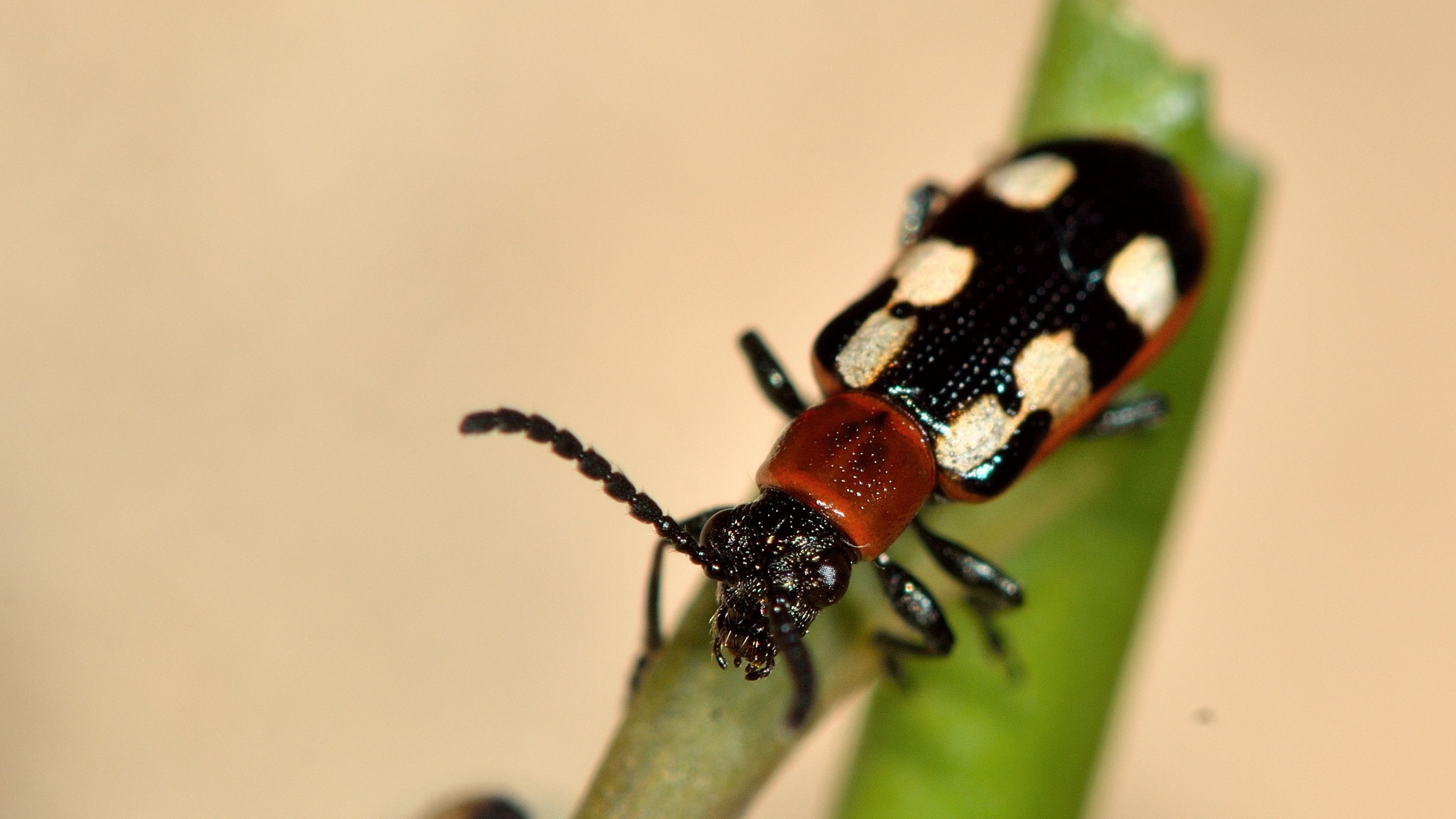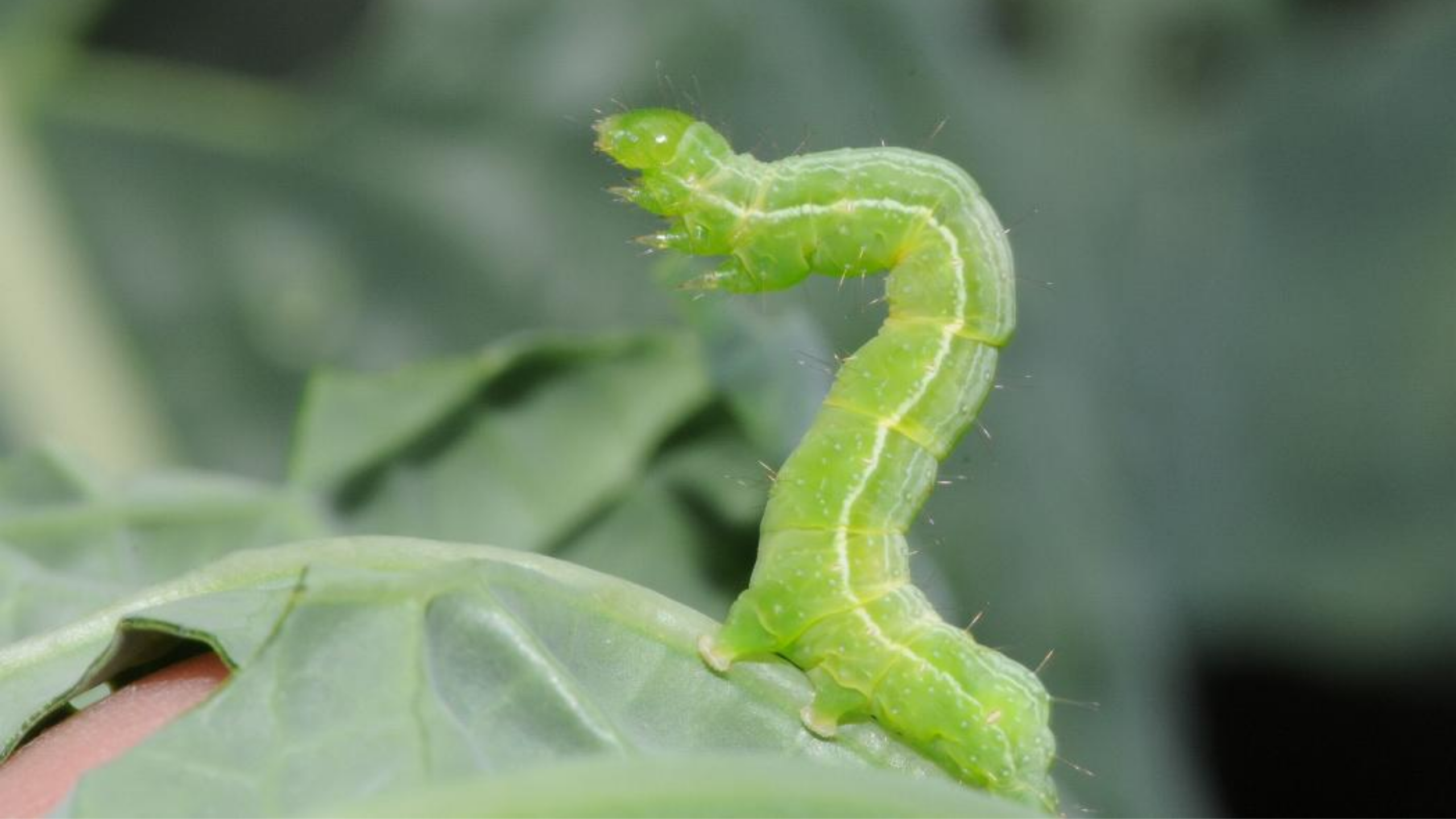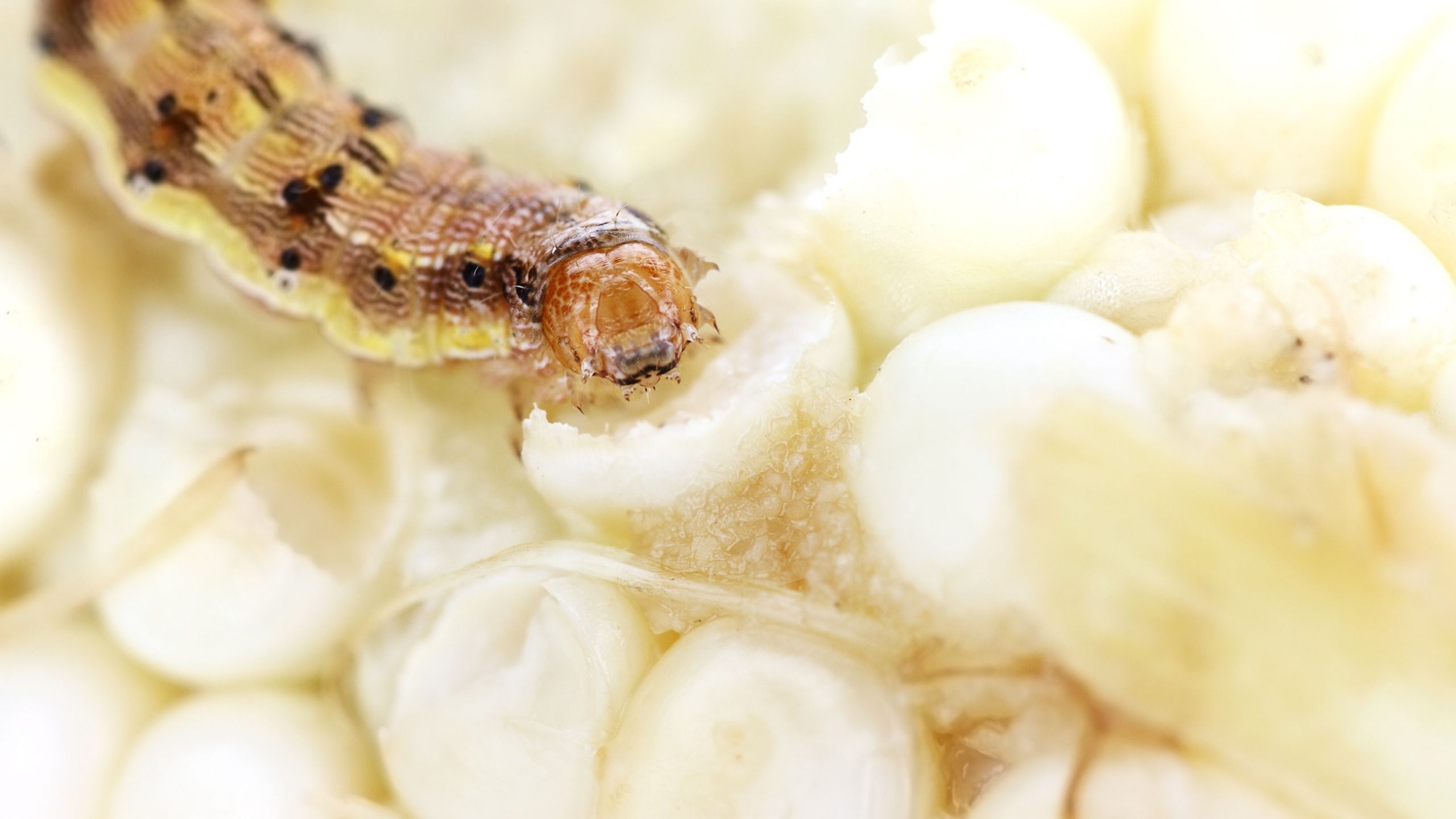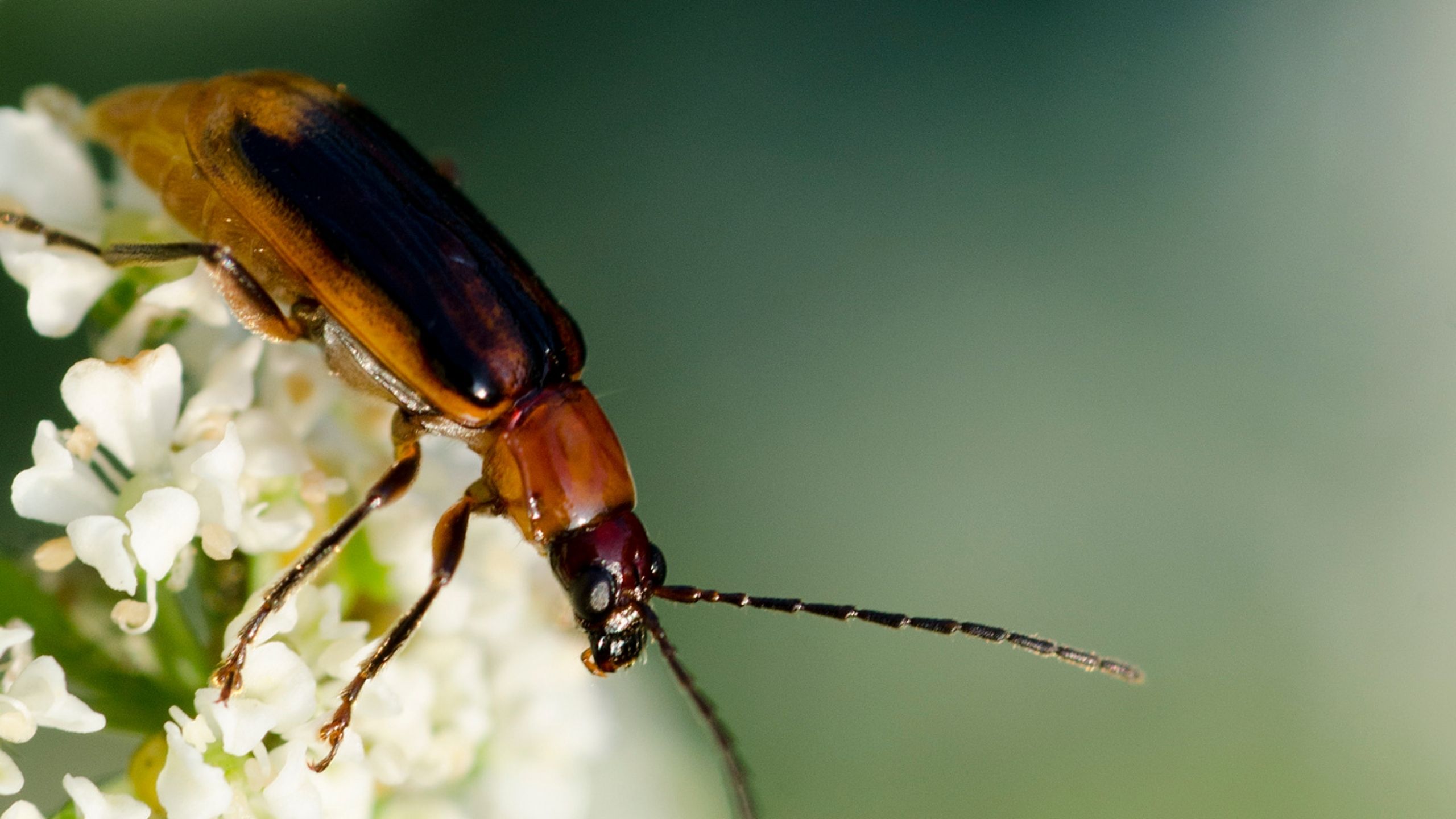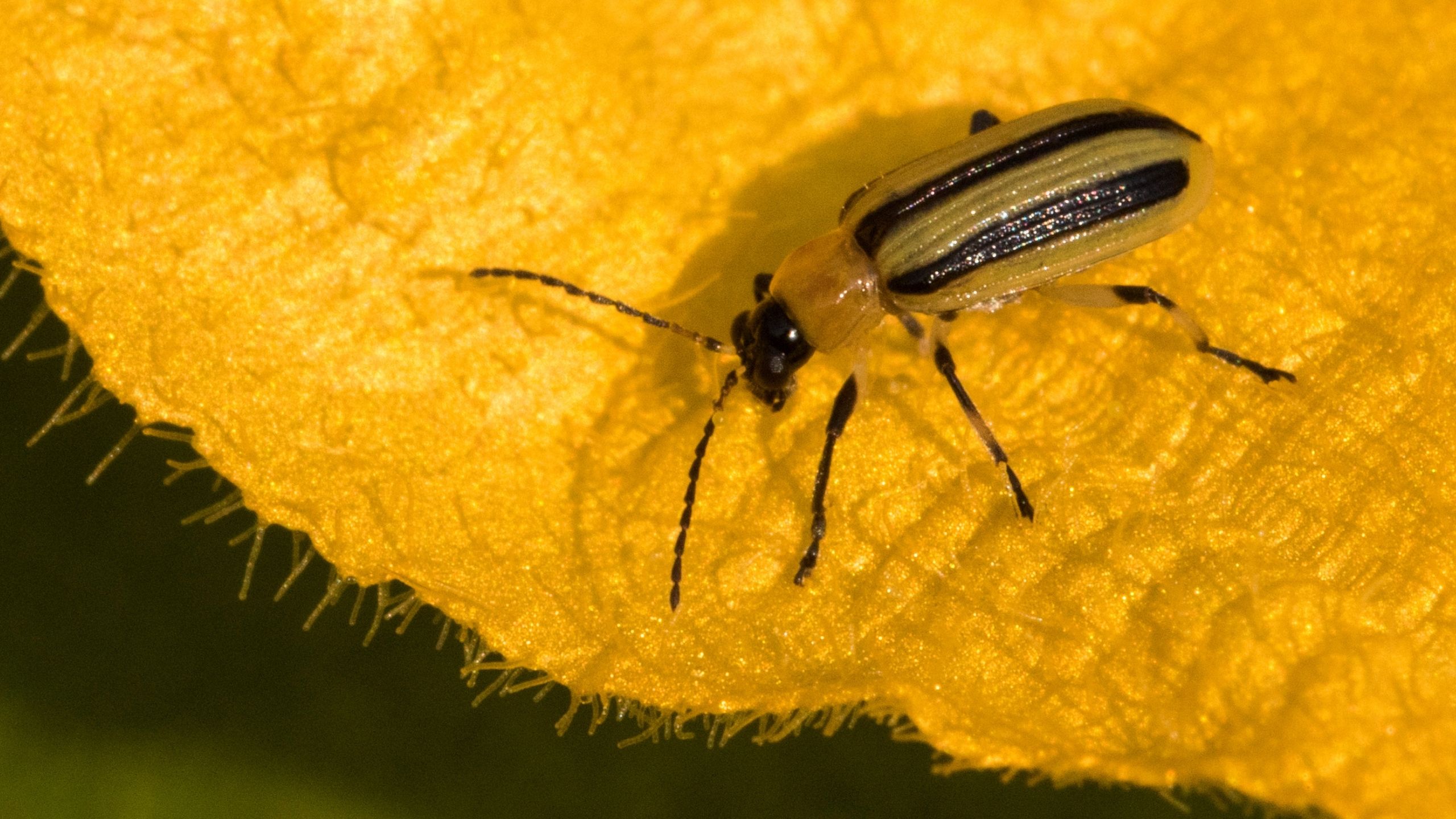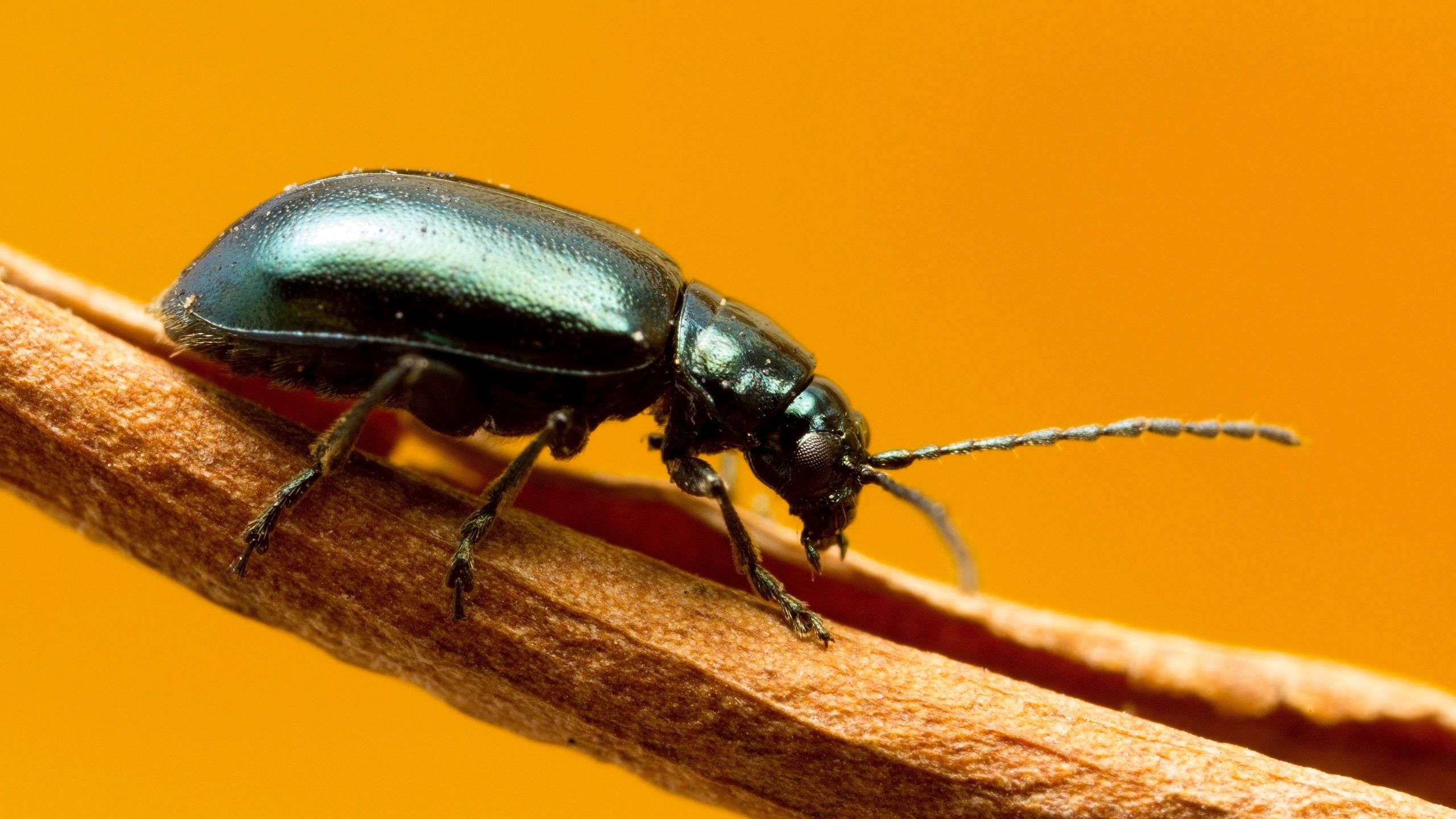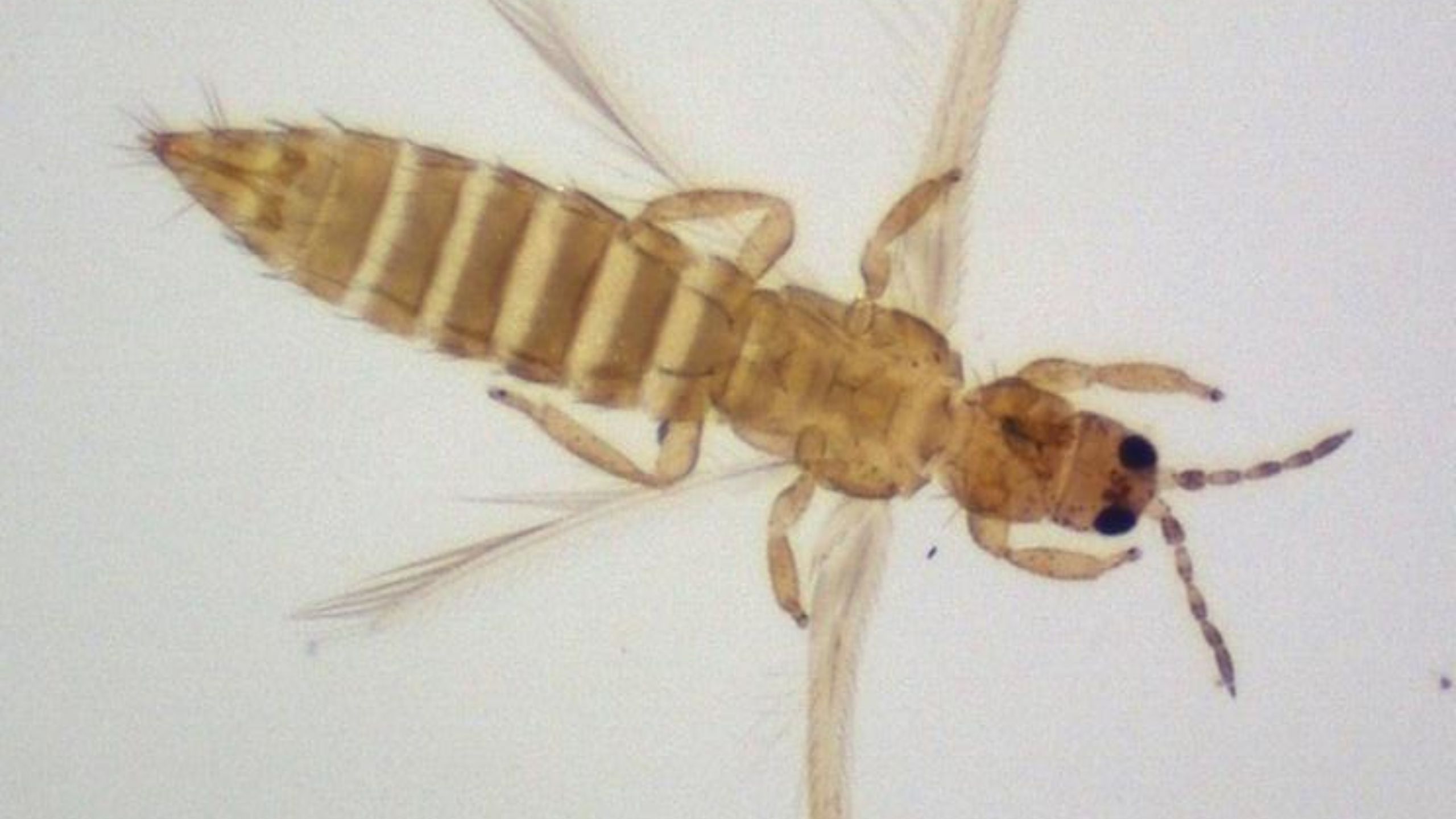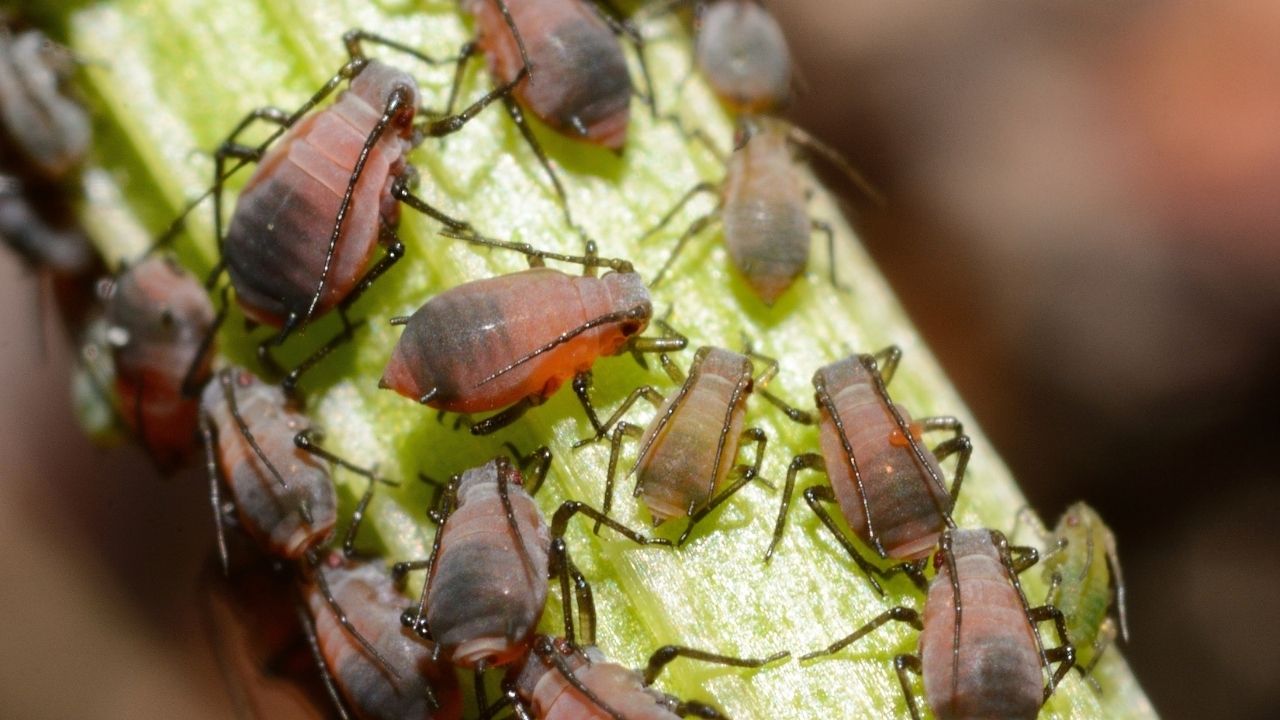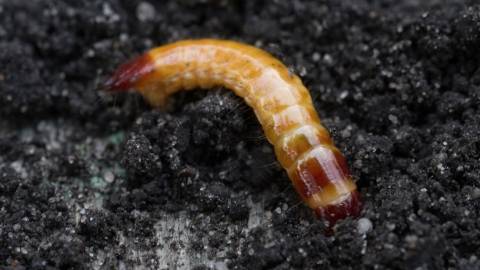Squash Bugs
(Anasa tristis)
August 2008
Diane Alston, Extension Entomologist (No longer at USU) • James Barnhill, Agriculture Agent (Weber/Morgan Counties)
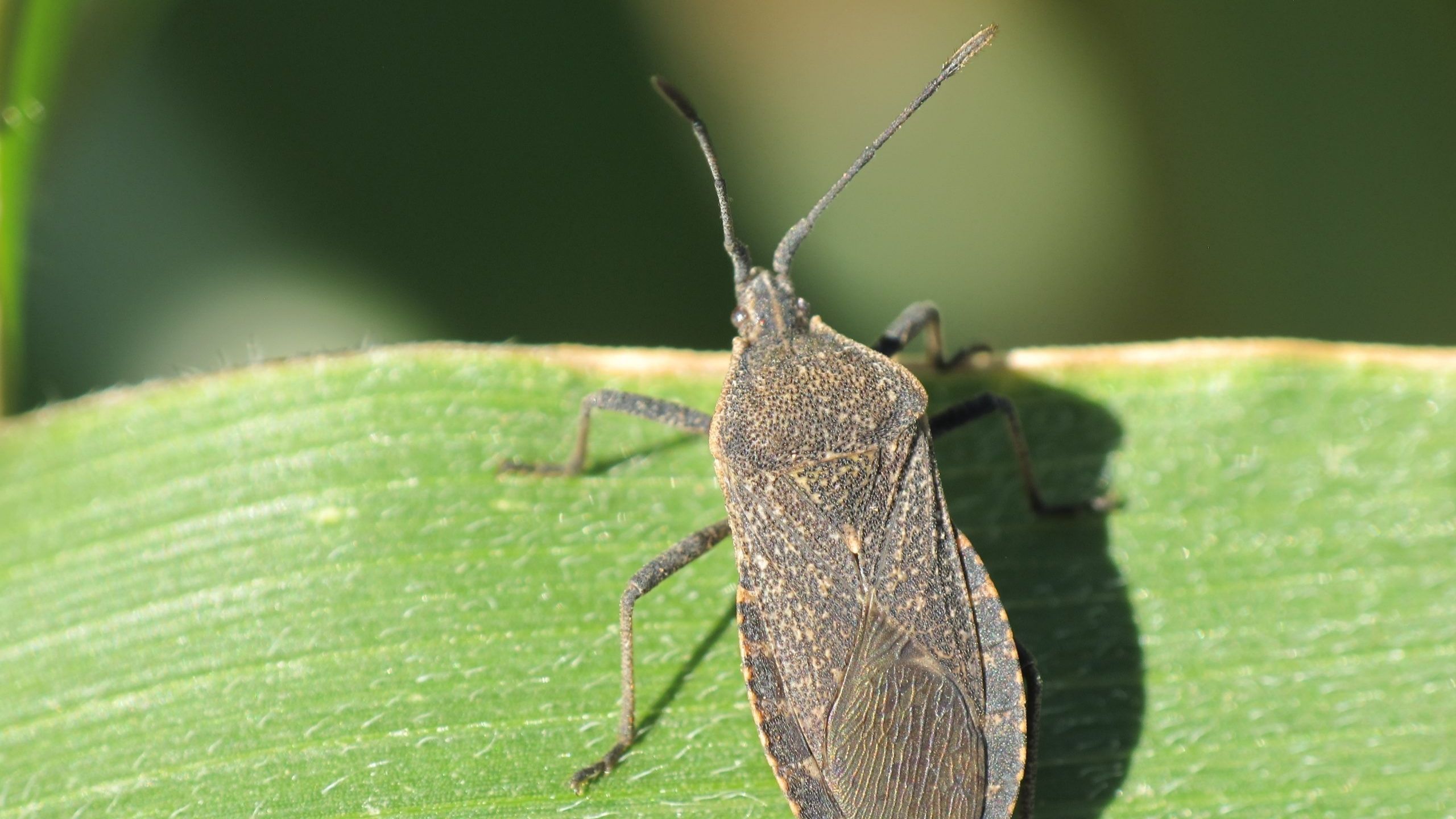
Fig. 1. Squash bug adult
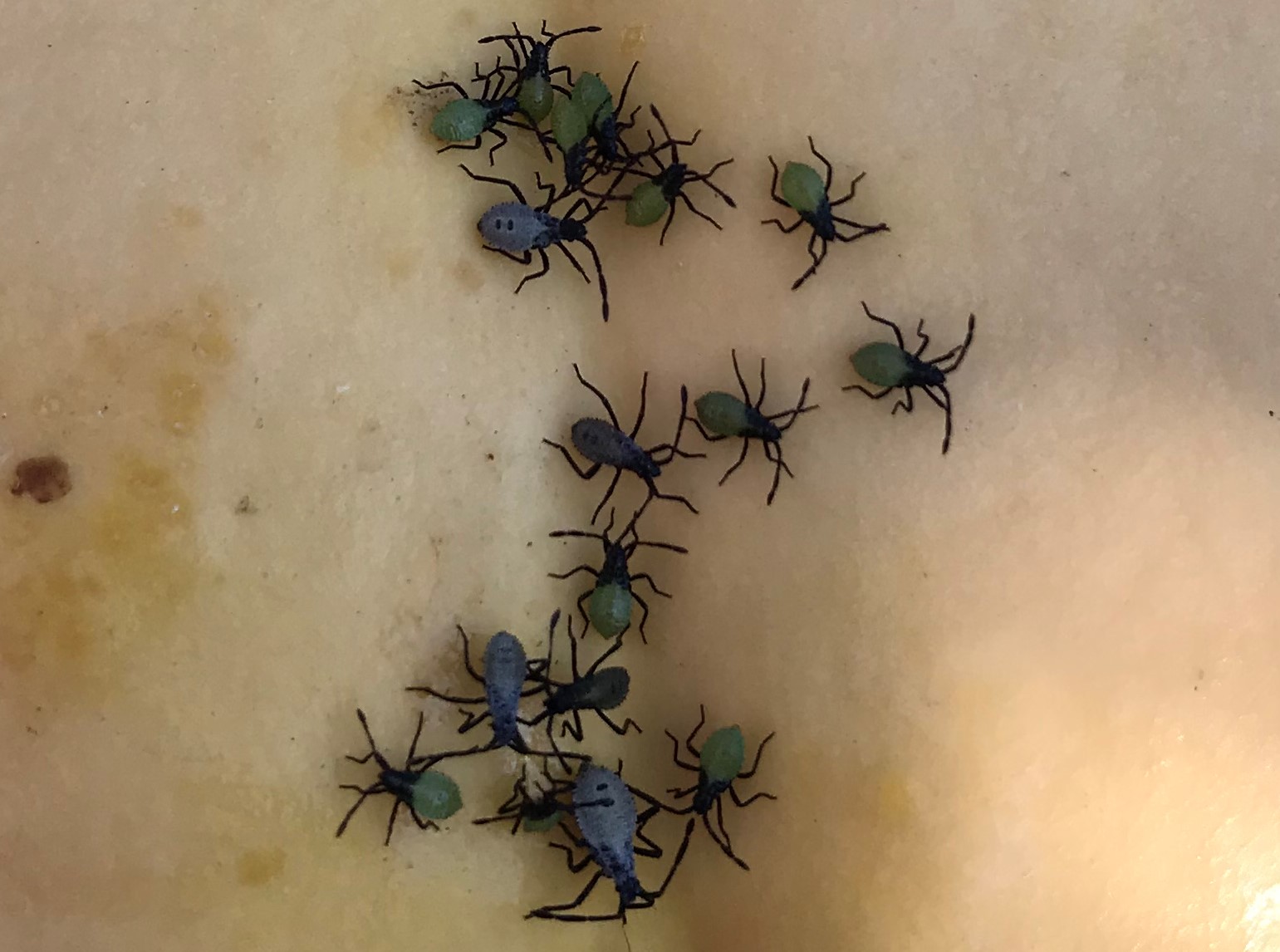 Fig. 2. Squash bug nymphs
Fig. 2. Squash bug nymphs Fig. 3. Squash bug egg mass
Fig. 3. Squash bug egg mass
Fig. 4. Wilting due to squash bug feeding

Fig. 5. Squash bugs mating
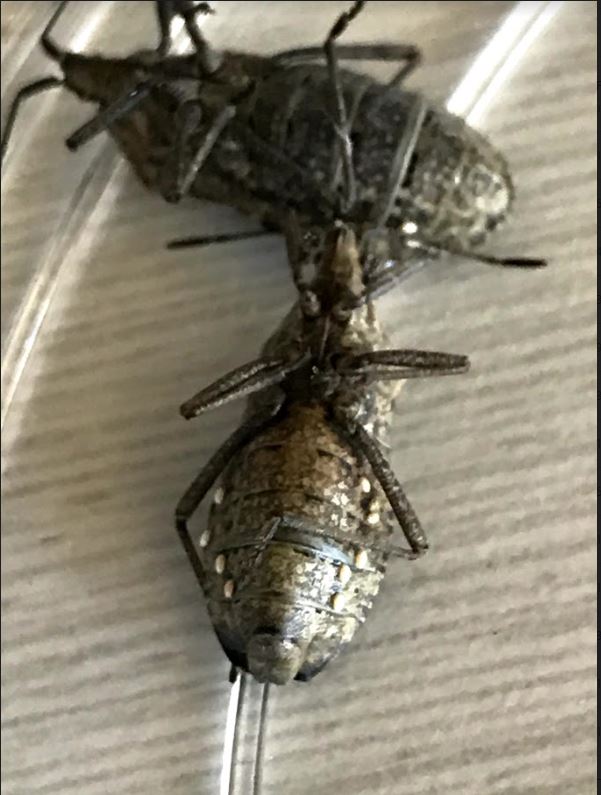 Fig. 6. Parasitized squash bug adults
Fig. 6. Parasitized squash bug adults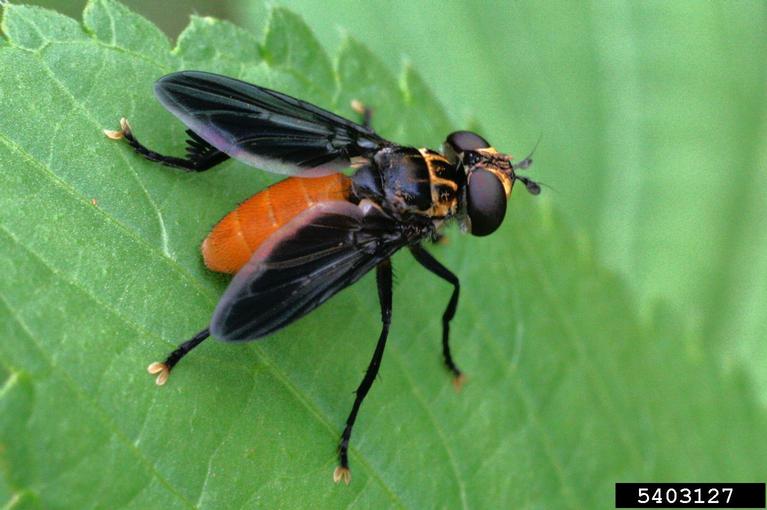
Fig. 7. A tachinid fly parasitoid of squash bug, Trichopoda pennipes. Image courtesy of Russ Ottens, University of Georgia, Bugwood.org.
Quick Facts
- In Utah, the squash bug is primarily a pest of squash and pumpkin.
- Plant injury includes leaf necrosis, scarred fruits, and rapid plant wilt.
- Squash bugs are prone to develop resistance to insecticides and adults are difficult to kill.
- Best management is achieved by suppressing squash bugs when eggs or nymphs are first detected.
- Preventive cultural and mechanical controls should be the first line of defense.
- One egg cluster per plant is the treatment threshold.
Squash bug (Anasa tristis) is a “true bug” with piercingsucking mouthparts (Order Hemiptera) in the leaffooted bug family (Coreidae). It is common throughout the U.S. and found from Canada to Central America. Adults emit a foul odor when disturbed and may be called “stink bugs”; however, true stink bugs are in a different true bug family. The insect spends the winter in the adult stage (Fig. 1). In the late spring to early summer, adults seek out young cucurbit plants on which to lay eggs. Adults and immatures (called nymphs) (Fig. 2) feed on leaves, fruits, and vines. Typical feeding symptoms include yellow to brown spots on leaves, and if feeding is heavy, entire leaves will turn black and dry out. Feeding on fruits can cause scars and desiccated, sunken areas. Entire plants may wilt when squash bug-feeding severs xylem vessels in vines. Injection of a toxin during feeding has been proposed as a cause for rapid plant wilt, but no salivary toxins have been confirmed in squash bugs.
Early to mid season population reduction is critical to effective squash bug management. Squash bugs are prone to develop resistance to insecticides and adults are difficult to kill. Sustainable management relies on cultural and mechanical practices, such as crop residue removal, resistant cultivars, crop rotation, maintenance of healthy plants, and hand removal of eggs and nymphs.
Hosts
All cucurbits are hosts, but pumpkin and squash are most attractive; cucumber, melons and gourds are less attractive. Pumpkins, ‘Hubbard’ and yellow (straightneck and crookneck) squash are more severely damaged than other squash varieties.
Life History
There is one generation per year in northern Utah. A partial second generation may occur in southern Utah, but that hasn’t been documented.
Adult - Overwinter, Dispersal, and Damaging Stage
- About 5/8 inch (1.6 cm) long; gray to brownish black; orange and brown stripes along edges of the abdomen (lower body); wings are folded over a fl at back (Fig. 1).
- Spend the winter as unmated adults in protected sites under plant debris, compost piles, around building foundations, etc.
- Emerge in spring (typically during April in southern Utah and during May in northern Utah), fly to host plants, feed, mate (Fig. 5), and lay eggs.
- A female can lay up to 250 eggs.
- The new, summer generation of adults appears in late June to July in northern Utah (3 to 4 weeks earlier in southern Utah), and feed on cucurbit hosts while they build up fat reserves to survive the winter.
Egg
- 1/16 inch (16 mm) long; oval; yellowish brown to brick red in color; eggs darken in color as they mature.
- Laid in clusters of 12-20 eggs on undersides of leaves, between leaf veins (Fig. 3).
- Laid from late spring through mid summer.
- Hatch in 10 to 14 days.
Nymph - Damaging Stage
- 3/16 – 1/2 inch (0.5-1.3 cm) long; fi ve instars (immature stages) that feed and complete development in 4 to 6 weeks.
- 1st instars: red head, antennae and legs; whitish to greenish gray bodies.
- 2nd to 3rd instars: black appendages and greenish gray bodies (Fig. 2).
- 4th and 5th instars: wing pads (small, undeveloped wings).
- Aggregate on vines (Fig. 4), leaves and fruits; disperse quickly when disturbed.
Crop Injury
Feeding Injury: Adults and nymphs feed on leaves, vines, and fruits with piercing-sucking mouthparts. Squash bugs suck sap from plants and can disrupt the fl ow of water and nutrients. Crop damage results from reduced yields and fruit quality, and storage losses. Early in the season, heavy feeding can kill seedlings and delay plant growth. However, seedling loss is uncommon in northern Utah where squash bug populations usually don’t become a problem until summer, after plants are well established. Feeding on leaves causes spots that are initially yellow and then turn brown. Heavy feeding will cause leaves to turn black and become crisp (Fig. 4). Feeding on fruits can cause scars and sunken areas that reduce marketability, and increase fruit rot during storage.
Sudden Wilt: Squash bug feeding on vines can injure or sever xylem vessels and cause wilt of plants above the point of feeding. “Sudden wilt” has been associated with aggregations of squash bugs on plants. Other plant bugs are known to inject toxins while feeding, but no toxin has been detected in squash bugs. Plant wilting appears to be caused by severe disruption of xylem vessels. In Utah during the 1990s, a sudden wilt disease of cucurbits was attributed to squash bug; however, in recent years, sudden wilt problems have diminished. This may be because growers maintain lower squash bug populations or changes in environmental conditions, but the reason is unknown.
Disease Vector: Sudden wilt symptoms mimic those of the disease, bacterial wilt, which is vectored by cucumber beetles. Bacterial wilt has not been found in Utah to date, but occurs in the eastern and central U.S. Recently a new disease has been associated with squash bug, cucurbit yellow vine disease (CYVD). This bacterium is transmitted by squash bug and colonizes plant phloem tissues.
CYVD can inflict heavy losses to melons, pumpkins, and squash. The disease has been detected in midwestern to northeastern states, but not west of the Rocky Mountains. CYVD symptoms include phloem discoloration, foliar yellowing, wilting, and plant decline.
Monitoring
Careful observation and monitoring of squash and pumpkin crops is the key to detection of squash bug infestations before they become established. Early detection is important because the smaller nymphal stages are easier to control with insecticides. In addition, early detection may allow for successful mechanical control by smashing adults and egg masses before they become numerous. Each adult that is eliminated can reduce the future squash bug population by several hundred.
Cucurbit plantings should be monitored at least once a week. An average of one egg cluster per plant is the economic threshold to apply an insecticide.
Take the time to carefully examine leaves and look on the undersides for eggs and newly hatched nymphs. Look at the base of the plant and under dropped leaves for adults. Squash bug infestations tend to become established about the time plants are 2 to 3 feet in diameter. Pay particular attention to plants that look wilted as they often have squash bugs. Wilted plants should be removed and adjacent plants checked for squash bugs.
Adult squash bugs are hardy and difficult to kill with insecticides. Once eggs are produced, on-going management to suppress nymphs and summer generation adults may be necessary. Early detection and suppression are important for sustainable management. Warm winters favor survival of adults and increase the likelihood of higher populations the following year.
Management
Cultural Control
One of the most important preventive strategies is to maintain healthy plants through proper planting site selection, soil preparation, fertilization and irrigation. Healthy plants are generally less attractive to pests and can tolerate more squash bug feeding without significant yield loss.
- Field Sanitation. In the late summer and fall, adult squash bugs continue to search for food to build up energy reserves and seek protected sites to spend the winter. Preventive steps should be taken to minimize populations of overwintering adults. Immediately following harvest, destroy cucurbit crop debris, including vines and fruits. Remove wood piles and other debris near fields where insects may seek protection for the winter.
- Resistant Varieties. There is no known immunity of cucurbits to squash bugs; however, some squash varieties have relative resistance, or lower susceptibility, as compared to other varieties (Table 1).
- Timing of Plantings. There are two strategies that have shown success in avoiding the peak period of squash bug immigration and egg-laying in new cucurbit plantings. The first is to plant seeds and transplants of susceptible cucurbit cultivars as early as is feasible for spring environmental conditions to give the crop a “jump start” in relation to squash bug adult colonization. The plants will be larger and more mature when squash bugs begin to lay eggs, and severe injury may be avoided. The second strategy is to delay planting susceptible cultivars to allow other cucurbits in the area to serve as “trap crops” early in the season (see description of trap crops below). Both planting strategies avoid the major period when squash bugs emerge from overwintering sites, colonize cucurbit hosts, and begin to lay eggs on young to mid-sized host plants. Peak dispersal of overwintered adult squash bugs typically occurs in late May in northern Utah and in late April to early May in southern Utah.
- Trap Crops. Trap crops should include cucurbit cultivars that are attractive to overwintering adult squash bugs and grow quickly in the early season. A study conducted by Oklahoma State University found that squash bugs prefer to lay eggs on yellow straightneck and crookneck as compared with zucchini, acorn, spaghetti, and butternut (Bonjour et al. 1990). For fi eld plantings, plant the trap crop along field borders or interspersed as clumps throughout the field. Overwintered adults will be lured to the trap crop before the main crop is attractive. Apply an insecticide or mechanically destroy the trap crop before eggs begin to hatch to reduce squash bug populations that would attack the later maturing main crop.
- Crop Rotation. Rotation to non-cucurbit crops in alternating years can reduce numbers of immigrating adult squash bugs. Rotation will be most effective in larger fields
- Mulches. In general, mulches can harbor squash bugs and are not recommended. However, mulches (straw, wood chips, paper, plastic, etc.) can suppress weeds, attract beneficial insects, and reduce soil moisture loss; thus, the numerous benefi ts may outweigh the negatives if used in combination with other practices, such as row covers (see below).
Mechanical Control
- Traps that attract adults and nymphs seeking protection include wooden boards, shingles, and heavy cardboard placed on the ground. Place the trap materials next to plant rows. Squash bugs will tend to aggregate under the traps at night. In the morning, turn the boards over and destroy the bugs mechanically or with insecticides.
- Row Covers. Floating row covers or plant fabrics (e.g., Reemay™, Agriforce™, Agribon™, Tufbell™) can prevent adult squash bugs from locating and landing on cucurbit crops in the late spring and early summer. Row covers must be tightly secured to prevent bugs from accessing plants. Covers must be removed when plants begin to flower for pollination to occur. Also, weed control under covers must be maintained by mulches, pre-emergent herbicides, or occasional removal of covers to physically remove weeds. Row covers may be more practical for organic and small commercial fields, and home gardens. The cost of plant fabric and the logistics of keeping floating covers secured on long plant rows make it less practical for large commercial fields.
- Hand-picking adults and nymphs, and smashing egg clusters on leaves can reduce squash bug populations. This technique will be most successful if started early in the season and done every 2 to 3 days to keep numbers low. Mechanical destruction of squash bugs is most suitable for home gardens and small plantings.
Biological Control
The most common natural enemies of squash bugs are parasitoids, insects that develop on or within their hosts (Fig. 6) and kill them in the process. Parasitoids include a tachinid fly, Trichopoda pennipes (Diptera: Tachinidae) (Fig. 7), that attacks older nymphs and adults, and several wasps that parasitize eggs (Hymenoptera: Encyrtidae and Scelionidae). About a dozen species of parasitic wasps that attack squash bugs have been documented in Kansas (Bauernfeind and Nechols 2005). Natural enemies of squash bug have not been surveyed in Utah. Predation of squash bugs tends to be low because the bugs release a noxious odor when attacked that repels predators. Natural enemy populations can be preserved by avoiding the use of broad spectrum, toxic insecticides and enhancing crop and soil health through cultural practices. Flowering plants that provide nectar and pollen can serve as alternative food sources for insect parasitoids. Wildflowers, herbs, and other plants have been shown to attract parasitic wasps and fl ies, and their presence in the crop habitat may improve biological control of squash bugs.
Chemical Control
Insecticides can be effective for control of squash bugs, but should not be used as the fi rst or sole management tool. Combine insecticides with cultural, mechanical, and biological tactics for longer-term, sustainable management. Adult squash bugs are resistant to insecticides, so if you choose to use an insecticide, begin shortly after egg hatch. To be effective, insecticide sprays must penetrate the plant canopy and thoroughly cover the top and underside of leaves, fruits, and vines. It is more diffi cult to achieve thorough spray coverage of large plants with dense canopies. Therefore, insecticides should be applied before dense plant canopies are formed.
Apply insecticides in the early morning or late evening when sprays will dry more slowly and result in better coverage of the vegetation. In the morning hours, leaf position may be more upright and allow for better coverage of leaf undersides. Don’t spray during the day when plants are blossoming to avoid harming pollinators. High pressure and multidirectional nozzles may be helpful in obtaining uniform insecticide coverage.
To prevent development of resistance to insecticides in the squash bug population, it is important to rotate the chemical class or mode of action from application to application.
Further Reading and References
- Adam, K. L. 2006. Squash bug and squash vine borer: organic controls. National Sustainable Agriculture Information Service. ATTRA Publication #IP298.
- Bauernfeind, R. J., and J. R. Nechols. 2005. Squash bugs and squash vine borers. Kansas State University Agricultural Experiment Station and Cooperative Extension Service MF-2508, 8 pp.
- Bessin, R. 2004. Squash vine borer and squash bug. University of Kentucky College of Agriculture Entfact- 314, 2 pp.
- Bonjour, E. L., W. S. Fargo, and P. E. Rensner. 1990. Ovipositional preference of squash bugs (Heteroptera: Coreidae) among cucurbits in Oklahoma. Journal of Economic Entomology 83: 943–947.
- Bruton, B. D., F. Mitchell, J. Fletcher, S. D. Pair, A. Wayadande, U. Melcher, J. Brady, B. Bextine, and T. W. Popham. 2003. Serratia marcescens, a phloem- colonizing, squash bug-transmitted bacterium: causal agent of cucurbit yellow vine disease. Plant Disease 87: 937-944.
- Delahaut, K. A. 2001. Squash bug. University of Wisconsin, Extension Garden Facts A3755-E, 2 pp.
- Mitchell, P. L. 2000. Leaf-footed bugs (Coreidae) in Heteroptera of Economic Importance, edited by Schaefer, C. W., and A. R. Panizzi. CRC Press, London, UK, 828 pp.
Related Research


